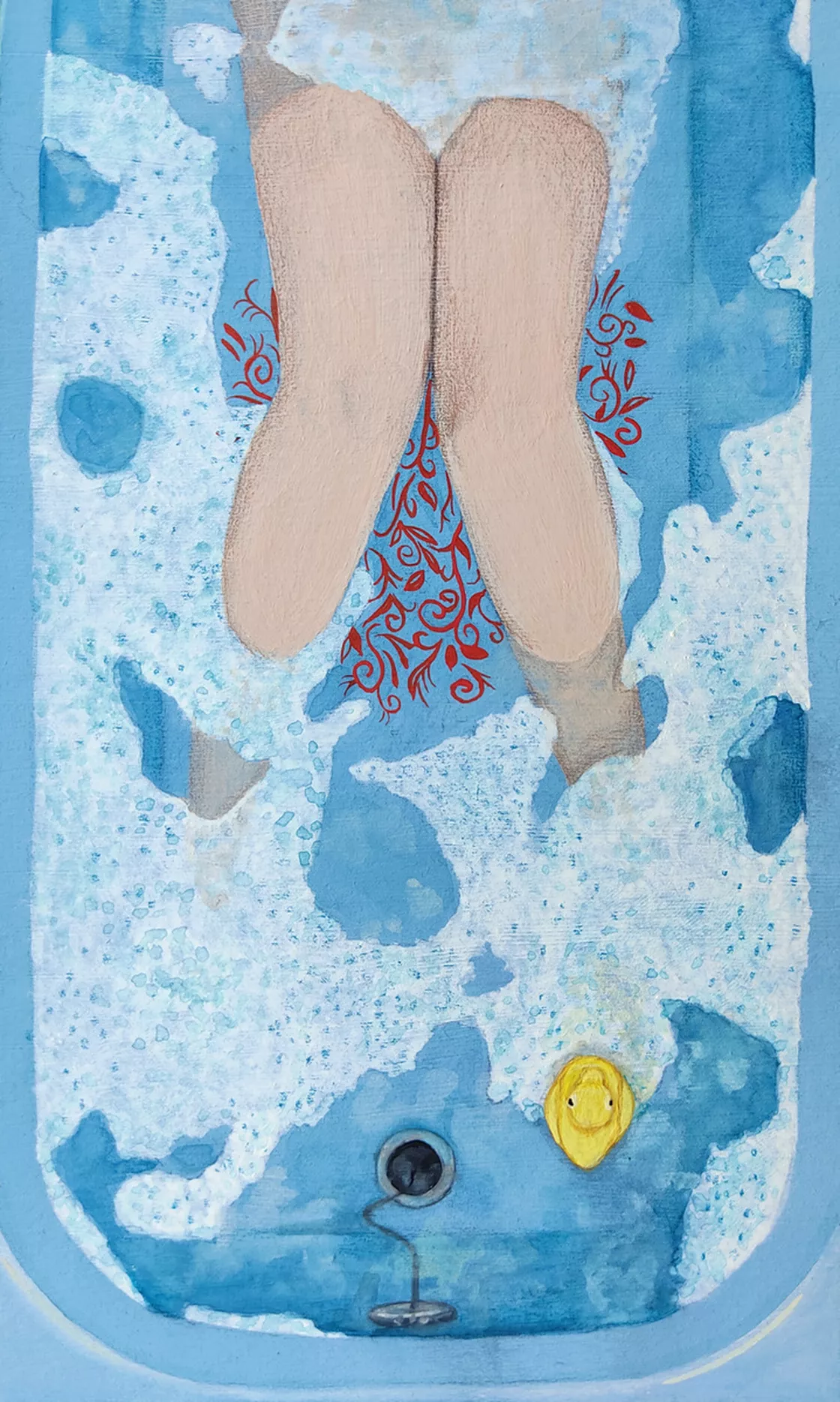The Uses of Cotton.
By Andreea Ceplinschi.
“What I learned that summer was how women get made and that it always hurts.”

Bathtub by Andromachi Giannopoulou.
Năvodari, 1998, age 13
Mother always knew best: merit-based financial aid was my opportunity to go to summer camp, even though we couldn’t afford it. She didn’t understand that the other kids going to camp saw it as pity; she viciously held on to the idea of our family being “middle class” in a recently post-communist country, recycling newspaper to wipe our asses, but school shirts always bleached and starched. I swallowed my anger, salty and wet, as she fitted me into our neighbor’s old two-piece bathing suit, securing the back with a safety pin where the clasp should have been. I saw her glancing uneasily at my sparse dark hairs poking out the sides of the faded blue bikini bottom, at the uneven lumps on my chest, and the soft pudge of my stomach. I didn’t understand any of it, but mother could read omens on my body, so she packed a pack of cotton in my bag.
Summer Camp, July 1998: 11 girls, 7 boys, 2 supervising teachers, one teacher’s husband (spouses went for free). The camp quarters were a decommissioned military hospital, a large open hall with iron-grated windows, polished concrete floors, and rows of single beds against the walls, each with their own three-drawer metal nightstand that doubled as dresser. We all unpacked together, boys separated from girls by a floor-length cotton curtain down the middle, and greedily eyed one another’s possessions to see who had the best. I was the youngest on that trip, my body still a tadpole growing out of its tail, shedding feathers for fur. I had second-hand clothes and a pack of cotton the other girls laughed at behind cupped hands. I didn’t understand why, mother hadn’t packed instructions with it.
On the third night of camp, one of the girls woke us up crying quietly:
Help me, I’m bleeding.
A few of us got up, quiet and barefoot in our pastel-colored cotton PJ’s and nightgowns, and followed her like ghosts down the hall to the bathroom. There were no doors on the stalls and no seats on the toilets, but she sat herself on the edge of a grimy bowl and leaned against the wall, hands clasped loosely together and moving with her stomach and the breath of God. Rain pelting against the iron-grated windowpanes sounded like someone was throwing rocks and though we couldn’t tell how the storm had made its way in, the floor was wet with rainwater, piss, and blood. She kept sobbing softly, a sound that only the other girls heard because they all came, and nobody said a word, but one of us took her nightgown off and started running cold water in the sink, another two grabbed her under the arms, careful not to touch her bruises, and carried her to the shower, and I also knew to go and bring my pack of cotton, and nobody laughed at it then.
We finished camp because back then things didn’t end because of female troubles. The other girls still didn’t speak to me, but they also never laughed again.
What I learned that summer was how women get made and that it always hurts. I felt it shift and cramp inside me on the train ride home and one of the other girls showed me how to tie my sweater around my waist to hide the omens mother had seen, spilling dirty inside my pink cotton underwear, no longer suitable for my age.
The Blood Pudding – February 19, 2024
Andreea Ceplinschi is a Romanian immigrant writer, waitress, and kitchen troll living and working at the tip of Cape Cod. She writes poetry, fiction, and creative non-fiction. Her work has been featured in Solstice Literary Magazine, Cathexis Northwest Press, Hare’s Paw Literary Journal, The Blood Pudding, and elsewhere. When not writing for herself, she volunteers for Passengers Journal. Find out more about her at poetryandbookdesign.com
Artwork: Andromachi Giannopoulou was born in Australia. She went to school in Athens, Greece, and studied Painting in Athens School of Fine Arts. Her work is the result of a search for the nature of personal experience, by exploring the boundaries between “real life” and memory and between “real life” and dream. You can find her work here.
